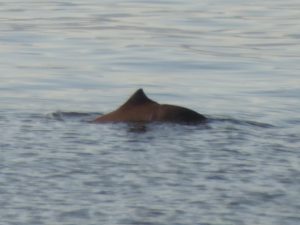Scientific Name
Phocoena phocoena
Conservation Status (IUCN)
Global population: Least Concern (evaluated but not qualified for any other category)
The Baltic Sea population is listed as Critically Endangered, and the Black Sea subspecies (Phocoena phocoena ssp. relicta) is listed as Endangered.
Range
Harbour porpoise inhabit cold temperate to sub-polar waters of the Northern Hemisphere, usually in continental shelf waters. Their wide range includes parts of the Atlantic and Pacific Oceans, the Arctic Sea, Black Sea and Baltic Sea.
Physical Description and Identifying Features
Up to 1.9 m long. A triangular dorsal fin set just beyond the midpoint of the back with dark grey dorsal area and paler sides merging into white ventral areas.

Behavior and Ecology
Harbour porpoise are frequently seen in shallow bays, estuaries, and tidal channels, rarely at depths greater than 200 m. This species tends to surface in a gentle rolling motion, often in small, loose groups (2-8) or alone; larger groups post-breeding seen infrequently. Breaching, leaps and other conspicuous behaviours are rare. Maximum diving depth 220 m; sexually mature at 3-5 years with most calves born May – August.

Reproduction
Sexually mature at 3-5 years. Gestation for 10-11 months and calves weaned at 4-8 months. Lactation and pregnancy can overlap.

Lifespan
Up to 24 years, but 10 – 15 is more common in most regions examined.
Diet
Small fish, crustaceans, and cephalopods (squids, octopuses and cuttlefish).
Conservation Concerns
Incidental catches in fishing gear (especially gill nets) is the most significant threat to this species throughout its range. Chemical pollution, anthropogenic noise, vessel strikes, and chemical pollution are also ongoing issues. Harbour porpoise are hunted in Greenland but targeted fisheries have ceased elsewhere.

The Baltic Sea subpopulation has been assessed by IUCN as Critically Endangered. Historically large commercial catches reduced the population significantly and numerous incidental catches in fishing nets (including gill nets and trawls) represent a serious threat to this population, currently thought to contain fewer than 1000 individuals.
The Black Sea subspecies P. p. relicta has been classified by IUCN as Endangered. Isolated from other harbour porpoise, this population was exploited in directed fisheries which ceased in 1983. Incidental mortality in fishing nets remains a serious threat to this small population. Exacerbating this threat is the unreported and unregulated fishing in the Black Sea.
Further Reading and References
[zotpress items=”3CSNGVG3,U9B4DZRR” style=”apa”]